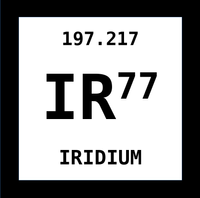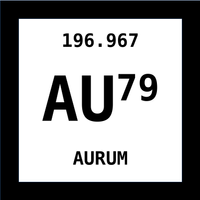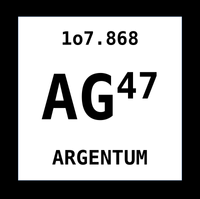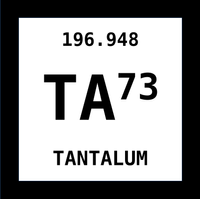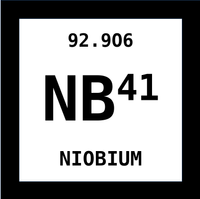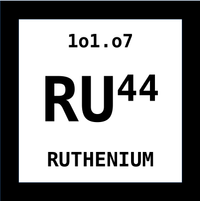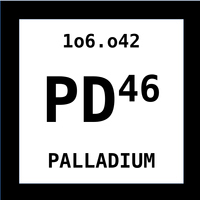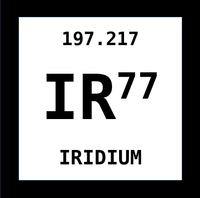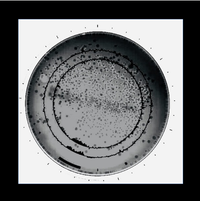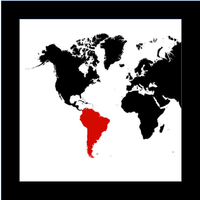IRIDIUM 77
Hydrogenation
Tennant discovered iridium in 1804 in the residue obtained on attacking impure platinum with aqua regia. Its name is derived from the Greek ιρις (rainbow) and reflects the various colours of its salts. Like platinum, it is a white metal, though with a glint of yellow. It is very hard and brittle. Its volumic mass (22,420 kg/m3) is only slightly less than that of osmium (22,570 kg/m3). Iridium has catalytic properties which enable its use in hydrogenation.
Electrolysis
In the automotive industry, iridium is used mainly as a component of exhausts for direct injection (GDI) engines and, to a lesser extent, in spark plugs. In the form of alloys with ruthenium, the metal is used in the manufacture of electrodes for the production of chlorine by electrolysis.
Synthetic single crystals
Iridium has also been used since 1995 as a catalyst in the production of acetic acid. Iridium linings and fabrications are also used in glass production because the metal is inert in contact with molten glass. In Other applications include crucibles used to grow synthetic single crystals for LED and data-storage technologies.
Pavillon de Sèvres
Iridium also serves as an alloying element to harden the platinum used in pacemakers, medical probes and other applications of this type. The 90% Pt–10 Ir alloy has an extremely low thermal expansion coefficient. It was selected to make the standard metre kept at the “Pavillon de Sèvres” in France.
Iridium (Ir)
Iridium (Ir), chemical element, one of the platinum metals of Groups 8–10 (VIIIb), Periods 5 and 6, of the periodic table. It is very dense and rare and is used in platinum alloys. A precious, silver-white metal, iridium is hard and brittle, but it becomes ductile and can be worked at a white heat, from 1,200° to 1,500° C (2,200° to 2,700° F). It is one of the densest terrestrial substances. In the massive state the metal is practically insoluble in acids and is not attacked even by aqua regia. It can be dissolved in concentrated hydrochloric acid in the presence of sodium perchlorate at 125° to 150° C (257° to 302° F).
The pure metal
Because of difficulties in preparation and fabrication, the pure metal has few applications. Iridium is chiefly used in the form of platinum alloys. Platinum-iridium alloys (5 to 10 percent iridium) are readily workable metals that are much harder and stiffer and more resistant to chemical attack than the soft pure platinum. Such alloys are used for jewelry, pen points, surgical pins and pivots, and electrical contacts and sparking points. The international prototype standard kilogram of mass is made from an alloy containing 90 percent platinum and 10 percent iridium.
In nature
Pure iridium probably does not occur in nature; its abundance in the Earth’s crust is very low, about 0.001 parts per million. Though rare, iridium does occur in natural alloys with other noble metals: in iridosmine up to 77 percent iridium, in platiniridium up to 77 percent, in aurosmiridium 52 percent, and in native platinum up to 7.5 percent. Iridium generally is produced commercially along with the other platinum metals as a by-product of nickel or copper production.
The world’s major producer
Iridium-containing ores are found in South Africa and Alaska, U.S., as well as in Myanmar (Burma), Brazil, Russia, and Australia. In the late 20th century South Africa was the world’s major producer of iridium.
Discovered in 1803
The element was discovered in 1803 in the acid-insoluble residues of platinum ores by the English chemist Smithson Tennant; the French chemists H.-V. Collet-Descotils, A.-F. Fourcroy, and N.-L. Vauquelin identified it at about the same time. The name iridium, derived from the Greek word iris (“rainbow”), refers to the various colours of its compounds. Natural iridium consists of a mixture of two stable isotopes, iridium-191 (37.3 percent) and iridium-193 (62.7 percent).
The chemistry of iridium
The chemistry of iridium centres on oxidation states of +1, +3, and +4, though compounds of all states from 0 to +6 are known with perhaps the exception of +2. Complexes in oxidation state +1 chiefly contain carbon monoxide, olefins, and phosphines as ligands. The anions hexachloroiridate, and hexabromoiridate, are the only notable chemical species containing iridium in the +4 oxidation state. Iridium is somewhat more reactive than ruthenium and osmium.
